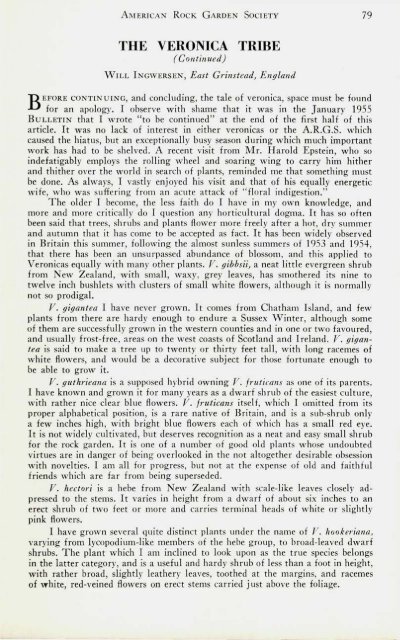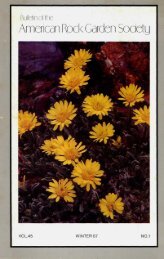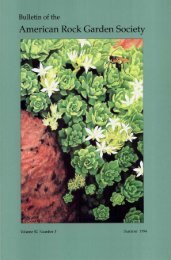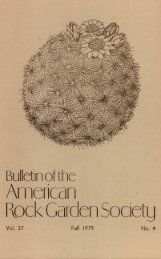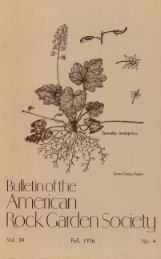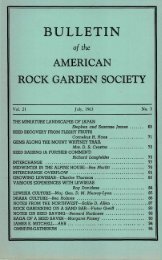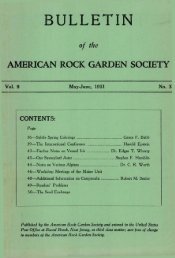Bulletin - July 1956 - North American Rock Garden Society
Bulletin - July 1956 - North American Rock Garden Society
Bulletin - July 1956 - North American Rock Garden Society
You also want an ePaper? Increase the reach of your titles
YUMPU automatically turns print PDFs into web optimized ePapers that Google loves.
AMERICAN ROCK GARDEN SOCIETY 79THE VERONICA TRIBE( Continued)WILL INGWERSEN, East Grinstead,EnglandT> EFORE CONTINUING, and concluding, the tale of veronica, space must be foundfor an apology. I observe with shame that it was in the January 1955BULLETIN that I wrote "to be continued" at the end of the first half of thisarticle. It was no lack of interest in either veronicas or the A.R.G.S. whichcaused the hiatus, but an exceptionally busy season during which much importantwork has had to be shelved. A recent visit from Mr. Harold Epstein, who soindefatigably employs the rolling wheel and soaring wing to carry him hitherand thither over the world in search of plants, reminded me that something mustbe done. As always, I vastly enjoyed his visit and that of his equally energeticwife, who was suffering from an acute attack of "floral indigestion."The older I become, the less faith do I have in my own knowledge, andmore and more critically do I question any horticultural dogma. It has so oftenbeen said that trees, shrubs and plants flower more freely after a hot, dry summerand autumn that it has come to be accepted as fact. It has been widely observedin Britain this summer, following the almost sunless summers of 1953 and 1954,that there has been an unsurpassed abundance of blossom, and this applied toVeronicas equally with many other plants. V. gibbsii, a neat little evergreen shrubfrom New Zealand, with small, waxy, grey leaves, has smothered its nine totwelve inch bushlets with clusters of small white flowers, although it is normallynot so prodigal.V. gigantea I have never grown. It comes from Chatham Island, and fewplants from there are hardy enough to endure a Sussex Winter, although someof them are successfully grown in the western counties and in one or two favoured,and usually frost-free, areas on the west coasts of Scotland and Ireland. V. giganteais said to make a tree up to twenty or thirty feet tall, with long racemes ofwhite flowers, and would be a decorative subject for those fortunate enough tobe able to grow it.V. guthrieana is a supposed hybrid owning V. fruticans as one of its parents.I have known and grown it for many years as a dwarf shrub of the easiest culture,with rather nice clear blue flowers. V. fruticans itself, which I omitted from itsproper alphabetical position, is a rare native of Britain, and is a sub-shrub onlya few inches high, with bright blue flowers each of which has a small red eye.It is not widely cultivated, but deserves recognition as a neat and easy small shrubfor the rock garden. It is one of a number of good old plants whose undoubtedvirtues are in danger of being overlooked in the not altogether desirable obsessionwith novelties. I am all for progress, but not at the expense of old and faithfulfriends which are far from being superseded.V. hectori is a hebe from New Zealand with scale-like leaves closely adpressedto the stems. It varies in height from a dwarf of about six inches to anerect shrub of two feet or more and carries terminal heads of white or slightlypink flowers.I have grown several quite distinct plants under the name of V. hookeriana,varying from lycopodium-like members of the hebe group, to broad-leaved dwarfshrubs. The plant which I am inclined to look upon as the true species belongsin the latter category, and is a useful and hardy shrub of less than a foot in height,with rather broad, slightly leathery leaves, toothed at the margins, and racemesof white, red-veined flowers on erect stems carried just above the foliage.


